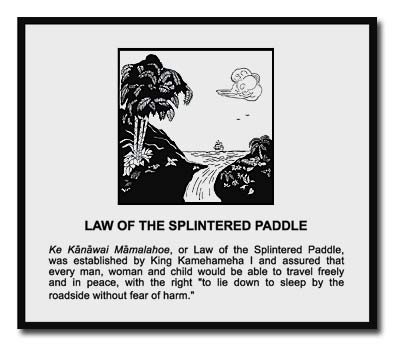
|
Kokua Line
|
Signs will be installed
at Kamehameha statue
Good news for the Kokua Line reader who asked about the lack of signs identifying King Kamehameha I's statue in front of the state Judiciary Building (Kokua Line, Jan. 10, 2005), as well for the thousands of tourists who visit the site each year:Descriptive plaques will be installed on four sides along the curbing that surrounds the statue in time for King Kamehameha Day on June 11, said state Comptroller Russ Saito.
When we first asked about the lack of signage at the statue, Saito agreed that there should be signs to explain why we honor King Kamehameha. As head of the Department of Accounting and General Services, which oversees state buildings, facilities and groundskeeping, he said he would expedite an effort to provide appropriate signs.
After just a few weeks, an agreement was reached to:
» Create four plaques to provide text for the four bronze tablets already at the base of the statue, which, Saito acknowledged, "you can't see."
The hope is to have all the plaques cast in bronze, but that still hasn't been decided.
Right now, the text is in English, but Saito said several groups are being consulted about providing translations in Hawaiian.
"We are hoping to have the English text plaques ready and mounted on the curb around the statue before the King Kamehameha Celebration this year," Saito said. "The Hawaiian language text plaques will be added as soon as we have them agreed upon."
He credited the state Foundation on Culture and the Arts for doing "a good job on the text."
He also said the King Kamehameha Celebration Commission, which is comprised of several Hawaiian groups, is helping to coordinate the effort.
Here's what the primary plaque will say, besides noting that Gould had cast the statue in bronze in 1883:
"As befits a man of enormous historic and symbolic importance, this statue depicts King Kamehameha I wearing the regalia of an ali'i nui (paramount chief or king), which includes the mahiole (feathered helmet), the 'ahu'ula (a long feathered cloak signifying chiefly rank), and the ka ei kapu o Liloa (the sacred sash of Liloa; a feathered sash, worn around the waist and over the shoulder, a symbol of supreme authority). He carries the ihe laumeki (barbed spear) in his left hand to symbolize his life as a brave warrior. He extends his right hand in a welcoming gesture of aloha to denote his life as a wise and just statesman and unifier of a people and a kingdom."
» Plaque for Tablet 1 (facing mauka) -- "Law of the Splintered Paddle"
See accompanying graphic below.
» Plaque for Tablet 2 (Diamond Head) -- "Ka 'Au Wa'a Peleleu"
"King Kamehameha I here reviews his famous 'au wa'a peleleu, a fleet of war canoes. The fleet, which consisted of up to 800 double-hulled canoes carved from massive koa trees, was capable of transporting up to 8,000 warriors between the islands."
» Plaque for Tablet 3 (makai) -- "Display of Courage"
"As a young boy, Kamehameha received training in the various Hawaiian martial arts while residing in Ka'u with his uncle Kalani'opu'u. Here the warrior-chief displays his courage and his special gift at deflecting and seizing spears hurled all at once."
» Plaque for Tablet 4 (Ewa) -- "Aboard the HMS Resolution"
"Offshore the island of Maui in 1778, the young chief Kamehameha is welcomed aboard the H.M.S. Resolution by British explorer Captain James Cook. Captain Cook commanded the first foreign fleet to visit the Hawaiian Islands."
It is not known exactly when Kamehameha the Great was born. He is believed to have been born between 1748 and 1761 in North Kohala, Hawaii. King Kamehameha V, by royal proclamation in 1871, designated June 11 as a holiday to honor his grandfather each year.
|

The Law of the Splintered Paddle is one of four descriptive plaques to be installed around the King Kamehameha Statue fronting the state Judiciary Building.
Mahalo
To the girl timer at last Sunday's Manoa Fun Run. She was the first timer who kept her voice down so as not to disturb the neighborhood. Every year, there was someone at the race who yelled loudly early in the morning. I talked to him and others about the noise but nothing changed. This year, I went and thanked the girl for being considerate of the neighborhood. -- Jim
|
Call 529-4773, fax 529-4750, or write to Kokua Line,
Honolulu Star-Bulletin, 500 Ala Moana Blvd., No. 7-210,
Honolulu 96813. As many as possible will be answered.
E-mail to kokualine@starbulletin.com
[News] [Business] [Features] [Sports] [Editorial] [Do It Electric!]
[Classified Ads] [Search] [Subscribe] [Info] [Letter to Editor]
[Feedback]
